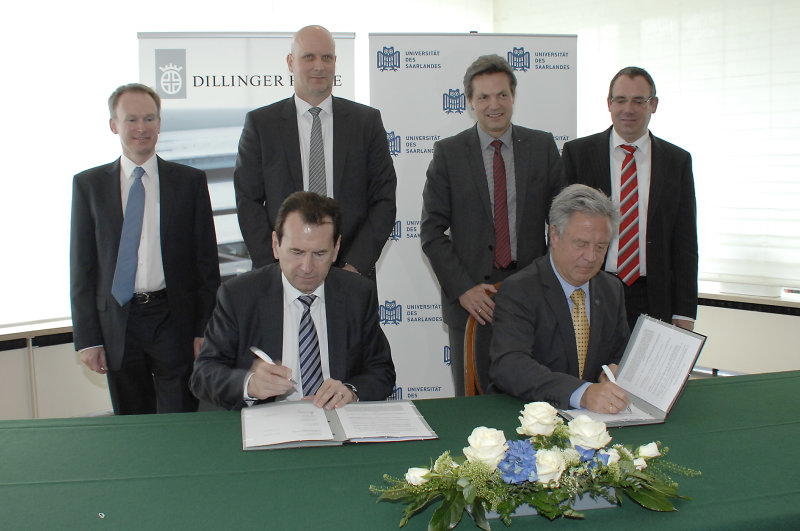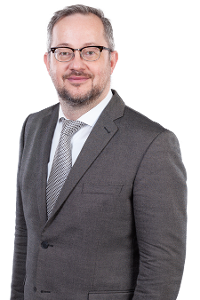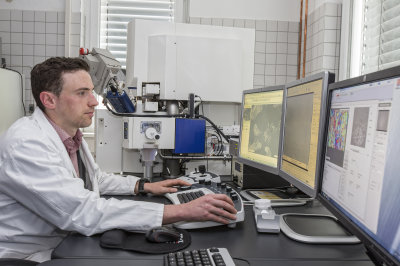
- News & Information
- Press Releases
Dillinger Hütte to fund materials research at Saarland University with nearly EUR 1 million
17. June 2015
Dillinger Hütte will begin cooperating even more intensively with the materials science and materials engineering program at Saarland University. Over the next three years the company will provide almost EUR 1 million in funding for steel-related joint research projects.
From the university’s side, three professors in materials science and materials engineering will be participating with their work groups in the strategic partnership. Dillinger Hütte hopes to use these joint research projects to further enhance the high quality of its heavy plate steel, which is used in applications such as steel construction, machine manufacturing, in wind power stations and in the offshore industry.
Dillinger Hütte Chief Executive Officer Dr. Karlheinz Blessing emphasized that this strategic partnership not only offers advantages due to close proximity but also due to the high quality of the planned joint research activities. “We have watched with interest as the materials science and materials engineering program at Saarland University developed into one of the five leading locations in Germany. It is valuable to us for intensive research in special steels and heavy plate to now continue in this environment with our support. This strengthens our own internal research activities and helps us acquire and secure competitive advantages in the fiercely competitive world market for heavy plate,” Blessing said.
University President Volker Linneweber, one of the signatories to the strategic partnership agreement in Dillingen, said he was very pleased that the university will now be working closely with one of Saarland’s most important large companies. “The advantage of this long-term partnership is that talented young researchers in materials science can now focus intensively on steel-related issues in their doctoral research. As a result, this subject – which is so important to Saarland – will be addressed directly on-site at the University,” Linneweber stressed.
Planned joint research projects
Foundations for offshore wind farms and petroleum drilling rigs are one example of the constructions made with high-performance steels from Dillinger Hütte. They have to be able to withstand the enormous stresses they are subjected to daily in the open sea, including tremendous sea currents, hurricane-force squalls and aggressive saltwater. “The heavy plate steel used here must ensure safe operation of the equipment even after years in extreme conditions. It has to be highly durable but at the same time must not become brittle or subject to fracturing,” explained Dr. Bernd Münnich, Executive Officer, Technical Division at Dillinger Hütte. Achieving the desired effects requires careful adjustment at a multitude of small points during the manufacture of special steels.
“We want to follow this complicated process from the materials science side in order to understand even more precisely how the internal structures of the heavy plate change during the individual production steps. This is the only way the possible weak points can be analyzed. In addition, we want to develop simulation methods we can use to better predict how special steel needs to be composed and treated in order to subsequently fulfill specific functions,” said Frank Mücklich, professor of functional materials at Saarland University. The materials scientist, who also heads the Steinbeis Forschungszentrum at the Material Engineering Center Saarland (MECS), has brought two Saarland University professors on board for the effort: Stefan Diebels specializes in engineering mechanics and Christian Motz is responsible for experimental methods in materials science. With the funding from Dillinger Hütte, each of the three scientists will now be able to take on one doctoral candidate for three years each, with the aim of advancing steel research in Saarland.
“We have developed various methods that allow us to better understand the complex inner life of a material. We can not only chemically analyze which atoms are arranged where but also can illustrate the grid structure of crystals and show which nanostructures are formed from these,” explained Professor Mücklich. This process also involves the Laboratory for Atom Probe Tomography, featured by only a few research centers in Germany, as well as other sophisticated two- and three-dimensional analysis technologies. “With these we are able to produce a spatial computer model that illustrates the internal structures of steel at the appropriate scale. This allows us to view the complex formation of the steel’s structure, which is composed of areas with differing crystal structures, during the production process.
Moreover, we can then reach conclusions as a team of three work groups as to why, for example, steel obtains different properties through a certain rolling method,” Mücklich explained.
In the work group of Christian Motz the focus will be on performing mechanical experiments with the materials to discover how the structure of the special steels changes during the individual production steps. For example, the group will examine how the strength of steel is influenced by temperature differences during forming or by various rolling techniques. The results of these experiments will help the researchers in Stefan Diebels’s team to develop theoretical physical models. These models will make it easier to predict the ideal way the structure of a special steel needs to look so that, for example, it will exhibit outstanding properties even when used in extremely low-temperature, Arctic conditions.
Press photos can be found at:

Innovative top-quality steel products, total orientation around our customers' needs and unceasing technological development in close cooperation with our partners form the basis of our success - as they have for more than 333 years.
© 2016 Dillinger All rights reserved.
Contact
AG der Dillinger Hüttenwerke
Werkstraße 1
66763 Dillingen/Saar
Tel.: +49 6831 47 0
Fax: +49 6831 47 2212
E-Mail: info@dillinger.biz
Imprint
| Data privacy statement
| T&C




